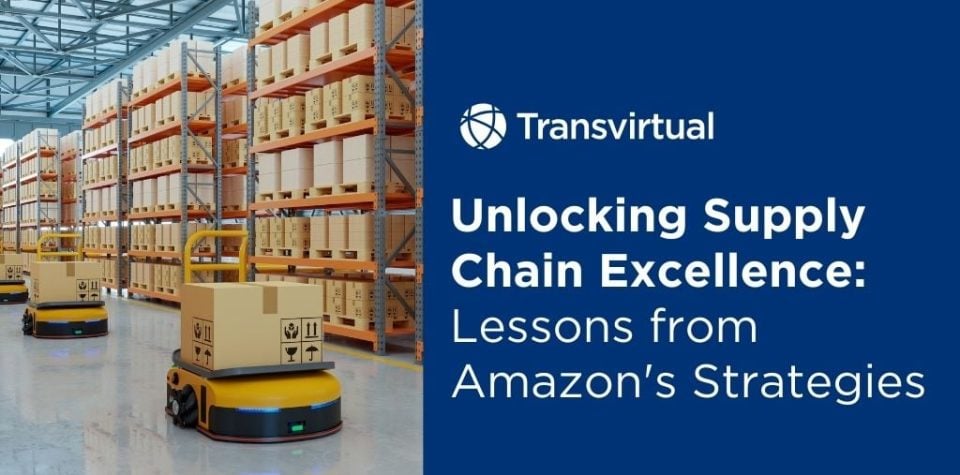Table of Contents
Every company wants to emulate Amazon’s success. What began as an online bookstore in 1994 has since grown into a global e-commerce giant, generating over $524 billion in net sales in 2022. Approximately 77 million US households are Amazon Prime members. What’s enabled this growth is Amazon’s supply chain—truly the gold standard in logistics and fulfillment.
By leveraging cutting-edge technology and a customer-first mindset, the company has transformed the way goods are stored, transported, and delivered. It is easy to take for granted now, but having almost any product delivered to your door in anywhere from 2 days to 2 hours has been truly revolutionary. If you want to emulate Amazon’s success, then understanding the core elements of its supply chain strategy is essential.
This article explores Amazon’s warehouse operations, customer-centric focus, and transportation logistics and shows how you can leverage Warehouse Management and Transport Management Systems to boost your operational efficiency, enhance customer satisfaction, and scale your supply chain seamlessly.
1. Warehouse Optimization: The Foundation of Speed
Amazon’s network of strategically located warehouses is integral to its ability to meet customer expectations. Each warehouse functions as a highly automated hub, employing robotics and AI-driven systems for inventory management, picking, and packing. By organizing warehouses to minimize the time and distance required for order fulfillment, Amazon ensures rapid processing.
What you can harness: A warehouse is more than a storage space—it’s a productivity powerhouse. You can replicate Amazon’s inventory tracking and picking efficiencies. By adopting advanced WMS tools that enable real-time inventory tracking, automated order picking, and smart space optimization, you can streamline processes and reduce overhead.
Incorporating technologies like RFID scanners and AI-driven algorithms further eliminates errors, accelerates fulfillment, and unlocks the full potential of warehouse operations.
2. Distribution Centers and Fulfillment Models
Amazon operates with a mix of distribution center types, including sortation centers, prime hubs, and cross-docking facilities. This layered structure allows the company to handle high volumes while tailoring operations to different delivery timelines. Their ability to segment high-demand products into regional centers ensures that fast-moving items are always within reach of key customer bases.
What you can harness: You don’t need Amazon’s scale to achieve flexibility—smaller companies can build resilience by adopting scalable strategies and tailored tools. Instead of maintaining large distribution networks, they can focus on partnering with third-party logistics providers (3PLs) for regional fulfillment or implementing micro-fulfillment centers closer to high-demand areas.
Moreover, cloud-based WMS and TMS platforms enable smaller businesses to manage inventory across multiple locations and dynamically allocate stock based on demand without requiring extensive infrastructure. This will allow you to emulate the agility of Amazon while staying cost-effective.
3. A Relentless Customer-Centric Approach
Amazon’s supply chain strategy revolves around exceeding customer expectations. Prime’s two-day (or even same-day) delivery guarantee has set the industry standard. Central to this is their commitment to data analysis, which enables real-time forecasting of demand and proactive inventory adjustments.
What you can harness: Customer satisfaction is the ultimate measure of supply chain success. While small companies may not be able to match Amazon’s fast delivery times, they can still adopt a customer-centric approach by offering personalized service, clear communication, and flexible options. Providing tailored recommendations, transparent shipping updates, and reliable customer support can significantly enhance customer satisfaction, fostering loyalty and repeat business.
In addition, smaller businesses have an edge here by offering personalized interactions that larger companies often overlook. This can include tailored recommendations based on purchase history, personalized thank-you notes, or customized packaging that makes customers feel valued and connected to your brand.
4. Transportation and Logistics Operations
Amazon’s ability to control transportation—through a combination of partnerships, owned assets, and advanced technology—ensures end-to-end visibility. Their fleet of delivery vans, aircraft, and ocean freighters reduces reliance on third parties and ensures consistency. Route optimization algorithms also enhance efficiency while reducing costs and environmental impact.
What you can harness: Owning your transportation strategy enhances control and scalability. By leveraging partnerships with 3PLs, you can access scalable, efficient logistics networks without the need for large-scale investment. Likewise, implementing a transportation management system will help you reduce freight costs and streamline route planning, potentially cutting transportation costs by 10-20%.
5. Embracing Technology for Seamless Integration
At the heart of Amazon’s success is its investment in technology to synchronize all supply chain components. Advanced analytics, IoT devices, and machine learning fuel a predictive and responsive system that minimizes delays and maximizes cost savings.
What you can harness: Technology is a force multiplier for supply chain operations. Integrating WMS/TMS platforms streamlines operations by connecting warehouse management, transportation, and customer service into one cohesive system, offering benefits like improved visibility, faster decision-making, and reduced operational silos.
You can adopt these platforms by choosing scalable, cloud-based solutions that easily integrate with existing systems, allowing them to achieve efficiency similar to larger organizations like Amazon without massive upfront costs. This integration not only enhances real-time data sharing but also boosts customer satisfaction by providing accurate tracking, faster responses, and improved delivery times.
Master Amazon’s Strategies to Deliver smarter, faster, and better
Amazon’s supply chain dominance is the result of its innovative approaches to warehousing, distribution, customer service, and transportation—all driven by an unwavering commitment to excellence. For businesses aspiring to achieve similar efficiencies, adopting advanced WMS/TMS solutions are the critical first step for revolutionizing their operations. By focusing on these key elements, companies can streamline processes, delight customers, and position themselves for long-term success.
Master your supply chain with Amazon-level efficiency. Learn how to apply their cutting-edge strategies and elevate your logistics to new heights. Discover how Transvirtual’s Warehouse Management and Transportation Management solutions can help you deliver smarter, faster, and better. Contact us today to learn more!



